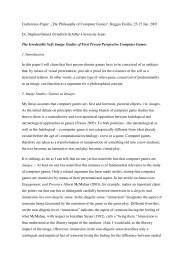Playing Dress-Up: Costumes, roleplay and imagination
Playing Dress-Up: Costumes, roleplay and imagination
Playing Dress-Up: Costumes, roleplay and imagination
You also want an ePaper? Increase the reach of your titles
YUMPU automatically turns print PDFs into web optimized ePapers that Google loves.
<strong>Playing</strong> <strong>Dress</strong>-<strong>Up</strong> Ludica<br />
most simplistic manifestation, players of World of Warcraft <strong>and</strong> other medieval-themed MMOG’s<br />
can adopt the tailoring craft, creating pre-designed “armor” based on supplies (collecting the<br />
requisite fabrics <strong>and</strong> dyes) <strong>and</strong> patterns. In There.com, player “developers” can download<br />
templates that allow them to design their own fashion items within a set of constraints, <strong>and</strong> must<br />
pay to put their merch<strong>and</strong>ise up for sale on There.com’s in-game auction site. In Second Life,<br />
players can customize their avatar dress on-the-fly, or design fantastical costumes that include<br />
elaborate geometries. While a great deal has been made of the buying <strong>and</strong> selling of virtual real<br />
estate, little research has been done on the economic ramifications of the virtual fashion industry.<br />
A notable exception is Chung’s research which shows that players are more likely to buy<br />
embellishments, behaviors <strong>and</strong> fashion items if they have a positive attitude towards their avatars<br />
(Chung 2005); thus the problem noted by Taylor (2003A) of women feeling less identification<br />
with their avatars could ultimately have economic repercussions if the player is less willing to<br />
invest in an avatar about which they have ambivalent feelings. Even in games like EverQuest,<br />
players are known to buy <strong>and</strong> sell valuable armor items on eBay <strong>and</strong> black market web sites.<br />
Fashion is possibly the sleeping giant of game economics.<br />
While games like EverQuest <strong>and</strong> World of Warcraft tend to control what players can do, where<br />
they can go, <strong>and</strong> what they can wear, by contrast, the creators of Second Life chose to create a<br />
world in which players create their own content <strong>and</strong> even retain the intellectual property to their<br />
work. The ultimate expression of the paidia side of dress-up, this has led to perhaps the most<br />
extensive <strong>and</strong> wide-ranging examples of digital dress-up in a variety of forms, especially in the<br />
fashion design mechanic. Second Life has built in tools for avatar customization; however,<br />
enterprising residents have discovered alternative methods, often through sheer inventiveness, to<br />
design their desired personas. Attachments, such as horns, tails, elaborate hair, extra limbs <strong>and</strong><br />
facial parts, have resulted in fantastical new species, perhaps drawn from some deep primordial<br />
source. Further, methods have been found to radically alter the basic avatar skeleton, folding it<br />
upon itself to create very small creatures, such as butterflies, <strong>and</strong> what seems to be an entire race<br />
of foot high “Furries” who cluster in their own communities. Several designers also create<br />
elaborate avatar clothing that would be physically impossible the real world, often accompanied<br />
by animations, special effects, <strong>and</strong> shiny or illuminated features known colloquially as “bling.”<br />
Figure 7: Creative avatars from Second Life (Images: Morie)<br />
Philosophy of Computer Games 2007 Page 9






